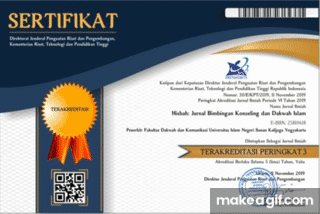DEVELOPMENT OF GRAPH-BASED CYBER COUNSELING MODEL WITH WEB-BASED APPLICATION PLATFORM
DOI:
https://doi.org/10.14421/hisbah.2022.191-02Abstract
Recently, almost everyone interacts with screen-focused technology. One of the forms of interaction with information technology is the use of smartphones. Smartphone is an object that is always close to someone. Due to this technology use, the application of counseling is increasing when it is associated with certain needs. counseling was once conducted in traditional way for quite long time. However, it is now mostly done virtually. Besides being able to be implemented in a remote context, counseling with a virtual platform is easier, more flexible, and can be done anywhere. The weakness that exists in virtual counseling is that it tends to be uncontrolled when viewed from the interaction pattern. Thus, the purpose of this study is to describe the pattern of interaction between counselors and counselees in virtual counseling services. The virtual counseling is run on a web application platform. The flow of communication and interaction is described by lines as segments. The final result shows that the interaction in cyber counseling services is relatively high. Another finding is the reaction made by the counselees that can successfully be identified, namely the counselee who is open and closed when expressing their problems to the counselor. Thus, the graph-based cyber counseling development model can predict which clients are open and closed.
Keywords: Development, Counselling model, Cyber Counselling, Graph-Counselling
 Abstract viewed: 463 times
|
Abstract viewed: 463 times
|
 Author Statement downloaded = 0 times
Author Statement downloaded = 0 times
 PDF downloaded = 317 times
PDF downloaded = 317 times
References
Bonci, A., Pirani, M., Dragoni, A. F., Cucchiarelli, A., & Longhi, S. (2017). The relational model: In search for lean and mean CPS technology. Proceedings - 2017 IEEE 15th International Conference on Industrial Informatics, INDIN 2017, 127–132. https://doi.org/10.1109/INDIN.2017.8104758
Budianto, A. E., Aziz, A., & Hidayah, N. (2019). ICT application in cyber counseling as a teacher accelerator with optimizing WhatsApp based mobile computing. Journal of Physics: Conference Series, 1375(1). https://doi.org/10.1088/1742-6596/1375/1/012006
Cheng, Y., Ding, P., Wang, T., Lu, W., & Du, X. (2019). Which Category Is Better: Benchmarking Relational and Graph Database Management Systems. Data Science and Engineering, 4(4), 309–322. https://doi.org/10.1007/s41019-019-00110-3
Dami, Z. A., & Waluwandja, P. A. (2019). Counselee Satisfaction In Face-To-Face and Cyber-Counseling Approach to Help Cyber-Bullying Victims in The Era of Industrial Revolution 4.0: Comparative Analysis. Oapub.Org, 6, 232–245. https://doi.org/10.5281/zenodo.3344908
Ghrab, A., Romero, O., Skhiri, S., Vaisman, A., & Zimányi, E. (2016). GRAD: On Graph Database Modeling. Computer Science : Database, 1(2), 1–28. http://arxiv.org/abs/1602.00503
Hor, A. E. H., Sohn, G., Claudio, P., Jadidi, M., & Afnan, A. (2018). A semantic graph database for BIM-GIS integrated information model for an intelligent urban mobility web application. ISPRS Annals of the Photogrammetry, Remote Sensing and Spatial Information Sciences, 4(4), 89–96. https://doi.org/10.5194/isprs-annals-IV-4-89-2018
Ishak, M. Ben, Leray, P., & Amor, N. Ben. (2016). Probabilistic relational model benchmark generation: Principle and application. Intelligent Data Analysis, 20(3), 615–635. https://doi.org/10.3233/IDA-160823
Ismail, A., Nahar, A., & Scherer, R. (2017). Application of graph databases and graph theory concepts for advanced analysing of BIM models based on IFC standard. Digital Proceedings of the 24th EG-ICE International Workshop on Intelligent Computing in Engineering 2017, July, 146–157.
Kan, B., Zhu, W., Liu, G., Chen, X., Shi, D., & Yu, W. (2017). Topology Modeling and Analysis of a Power Grid Network Using a Graph Database. International Journal of Computational Intelligence Systems, 10(1), 1355. https://doi.org/10.2991/ijcis.10.1.96
Liao, C. H., Wu, Y. F., & King, G. H. (2019). Research on Learning OWL Ontology from Relational Database. Journal of Physics: Conference Series, 1176(2). https://doi.org/10.1088/1742-6596/1176/2/022031
Medhi, S., & Baruah, H. (2017). Relational database and graph database: A comparative analysis. Journal of Process Management. New Technologies, 5(2), 1–9. https://doi.org/10.5937/jouproman5-13553
Mishna, F., Bogo, M., & Sawyer, J. L. (2015). Cyber Counseling: Illuminating Benefits and Challenges. Clinical Social Work Journal, 43(2), 169–178. https://doi.org/10.1007/s10615-013-0470-1
Ouyang, S., Zhang, Z., & Zhao, H. (2021). Dialogue Graph Modeling for Conversational Machine Reading. Computer Science : Database, 2(3), 3158–3169. https://doi.org/10.18653/v1/2021.findings-acl.279
Prasetiawan, H. (2016). Cyber Counseling Assisted with Facebook CYBER COUNSELING ASSISTED WITH FACEBOOK TO REDUCE ONLINE GAME ADDICTION. Jurnal of Guidance and Counseling, 6(1), 28–36.
Situmorang, D. D. B. (2020). Online/Cyber Counseling Services in the COVID-19 Outbreak: Are They Really New? The Journal of Pastoral Care & Counseling : JPCC, 74(3), 166–174. https://doi.org/10.1177/1542305020948170
Unal, Y., & Oguztuzun, H. (2018). Migration of data from relational database to graph database. ACM International Conference Proceeding Series, 1–5. https://doi.org/10.1145/3200842.3200852
Wu, Z., Pan, S., Long, G., Jiang, J., & Zhang, C. (2019). Graph wavenet for deep spatial-temporal graph modeling. IJCAI International Joint Conference on Artificial Intelligence, 2019-August, 1907–1913. https://doi.org/10.24963/ijcai.2019/264
Yoon, B.-H., Kim, S.-K., & Kim, S.-Y. (2017). Use of Graph Database for the Integration of Heterogeneous Biological Data. Genomics & Informatics, 15(1), 19. https://doi.org/10.5808/gi.2017.15.1.19

Downloads
Additional Files
Published
Issue
Section
License
Authors who publish with this journal agree to the following terms:
- Authors retain copyright and grant the journal right of first publication with the work simultaneously licensed under a Creative Commons Attribution License that allows others to share the work with an acknowledgement of the work's authorship and initial publication in this journal.
- Authors are able to enter into separate, additional contractual arrangements for the non-exclusive distribution of the journal's published version of the work (e.g., post it to an institutional repository or publish it in a book), with an acknowledgement of its initial publication in this journal.
- Authors are permitted and encouraged to post their work online (e.g., in institutional repositories or on their website) prior to and during the submission process, as it can lead to productive exchanges, as well as earlier and greater citation of published work.











